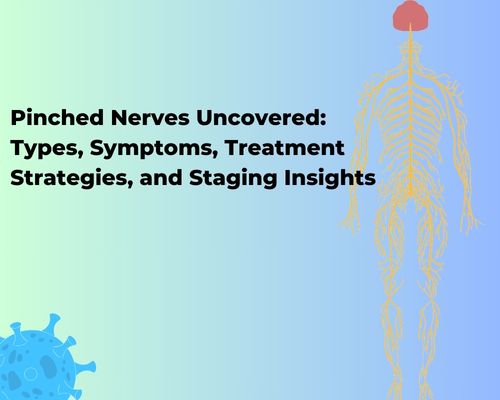A Comprehensive Guide to Pinched Nerves: Identifying Types, Symptoms, and Effective Treatments
A pinched nerve occurs when surrounding tissues—such as muscles, tendons, bones, or cartilage—apply excess pressure on a nerve. This pressure leads to irritation, inflammation, or damage, causing various symptoms, including pain, numbness, tingling, and weakness. Pinched nerves are common and can occur in different areas of the body, particularly the spine.
This guide covers the types, symptoms, causes, and effective treatments for pinched nerves, helping you better understand how to manage and prevent this condition.
Types of Pinched Nerves
Pinched nerves can occur in various regions of the body. Below are the most common types:
1. Cervical Radiculopathy (Neck)
- Cause: Compression of the nerve roots in the neck due to herniated discs, bone spurs, or narrowing of the spinal canal (spinal stenosis).
- Symptoms: Pain radiating down the arm, neck pain, tingling, numbness, or weakness in the arms and hands.
2. Thoracic Radiculopathy (Upper/Mid-Back)
- Cause: Less common than cervical or lumbar radiculopathy. Caused by a herniated disc or narrowing of the spinal space in the upper/mid-back region.
- Symptoms: Localized pain in the upper back or chest, radiating pain around the rib cage.
3. Lumbar Radiculopathy (Lower Back)
- Cause: Compression of nerves in the lower back due to herniated discs or degenerative changes (e.g., bone spurs).
- Symptoms: Sciatica (pain that radiates down one leg), numbness, tingling, or weakness in the legs, hips, or lower back.
4. Sciatica (Sciatic Nerve Compression)
- Cause: Compression of the sciatic nerve, typically due to a herniated disc or narrowing of the spinal canal in the lower back.
- Symptoms: Sharp, shooting pain down the leg, tingling, numbness, or weakness in the affected leg.
5. Carpal Tunnel Syndrome (Wrist)
- Cause: Compression of the median nerve at the wrist, often due to repetitive wrist movements, injury, or inflammation.
- Symptoms: Numbness, tingling, and weakness in the hand, especially in the thumb, index, and middle fingers.
6. Cubital Tunnel Syndrome (Elbow)
- Cause: Compression of the ulnar nerve at the elbow, often due to prolonged pressure or repetitive arm movements.
- Symptoms: Numbness or tingling in the ring and little fingers, pain at the elbow, and weakness in the hand.
Symptoms of a Pinched Nerve
The symptoms of a pinched nerve depend on its location and the severity of the compression. Common symptoms include:
- Pain: Often sharp, burning, or aching. Pain may radiate to other parts of the body, such as down an arm or leg.
- Tingling or “Pins and Needles” Sensation: Often felt in the arms, hands, legs, or feet.
- Numbness: Loss of feeling in the affected area, making it difficult to perform everyday tasks.
- Weakness: Difficulty using muscles controlled by the pinched nerve, leading to weakness in the hands, legs, or feet.
- Radiating Pain: Pain that extends from the neck, back, or spine into the limbs, often seen in conditions like sciatica or cervical radiculopathy.
- Reduced Reflexes: Slower or absent reflex responses in the affected limb.
Causes of a Pinched Nerve
Several factors can contribute to a pinched nerve, including:
- Herniated Discs: When a disc between the vertebrae slips out of place and presses on nearby nerves.
- Bone Spurs: Overgrowth of bone often due to aging, which can narrow the space around nerves.
- Spinal Stenosis: Narrowing of the spinal canal, which compresses nerves.
- Muscle Tension or Injury: Muscles or tendons that become tight or inflamed may place pressure on nerves.
- Repetitive Movements: Activities that involve repeated motions, such as typing or lifting, can lead to nerve compression.
- Poor Posture: Slouching or poor posture over time can cause misalignment and increase pressure on the spine and nerves.
Effective Treatments for Pinched Nerves
Treatment depends on the location, severity, and cause of the pinched nerve. The goal is to relieve pressure on the nerve, reduce inflammation, and restore normal nerve function. Treatment options are divided into non-surgical and surgical approaches.
Non-Surgical Treatments
- Rest: Limiting movements and activities that aggravate symptoms can help the nerve heal.
- Physical Therapy: Specific exercises to strengthen muscles, improve flexibility, and reduce pressure on the nerve.
- Medications:
- NSAIDs (Non-Steroidal Anti-Inflammatory Drugs): Reduce pain and inflammation.
- Corticosteroid Injections: Injected into the affected area to reduce inflammation and swelling around the nerve.
- Muscle Relaxants: Help relieve muscle spasms that may contribute to nerve compression.
- Heat/Ice Therapy: Applying ice packs to reduce inflammation or heat to relax muscles and alleviate pain.
- Ergonomic Adjustments: Adjusting posture or workstations to reduce strain on the nerves.
- Splints or Braces: Particularly for conditions like carpal tunnel syndrome, wrist splints can relieve pressure on the median nerve.
Surgical Treatments
If non-surgical treatments do not provide relief or if the nerve compression is severe, surgery may be necessary. Some common surgical options include:
- Discectomy: Removal of part or all of a herniated disc to relieve pressure on the nerve.
- Laminectomy: Removal of part of the vertebra to create more space for the affected nerve.
- Foraminotomy: Widening the openings between vertebrae (foramen) to alleviate pressure on nerve roots.
- Carpal Tunnel Release: Surgery to release pressure on the median nerve in cases of carpal tunnel syndrome.
- Spinal Fusion: Fusing two or more vertebrae together to stabilize the spine and prevent further nerve compression.
Prevention of Pinched Nerves
While not all pinched nerves can be prevented, you can reduce your risk by adopting the following practices:
- Maintain Proper Posture: Avoid slouching, especially when sitting for extended periods. Keep your spine aligned and ensure your workstation is ergonomic.
- Exercise Regularly: Strengthening your core, back, and neck muscles can reduce the strain on your spine and nerves.
- Stretching: Incorporating regular stretches into your routine can help maintain muscle flexibility and reduce tightness around nerves.
- Avoid Repetitive Movements: Take breaks if your work involves repetitive tasks like typing, lifting, or using your wrists.
- Stay Active: Keep your body in motion to avoid stiffness or muscle imbalances that could contribute to nerve compression.
- Maintain a Healthy Weight: Carrying extra weight puts additional stress on your spine, increasing the risk of nerve compression.
Conclusion
A pinched nerve can cause discomfort and disrupt your daily life, but with early detection and appropriate treatment, most people recover fully. By understanding the types, symptoms, and causes of pinched nerves, as well as effective treatment strategies, you can take proactive steps to manage the condition and prevent further issues.
If you’re experiencing symptoms of a pinched nerve, consulting with a healthcare provider early can help prevent permanent nerve damage and guide you to the best treatment approach.



